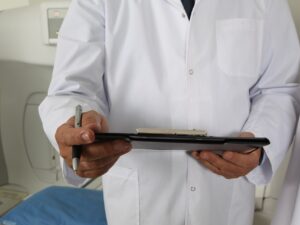 Juvenile systemic sclerosis (JSSc) is a rare disease of childhood and currently no international consensus exists with regard to its assessment and treatment. This SHARE (Single Hub and Access point for paediatric Rheumatology in Europe) initiative, based on expert opinion informed by the best available evidence, provides recommendations for the assessment and treatment of patients with JSSc with a view to improving their outcome. Experts focused attention not only on the skin assessment but also on the early signs of internal organ involvement whose proper treatment can significantly affect the long-term outcome. A score for disease severity is proposed in order to perform a structured assessment of outcome over time but a validation in a wider patient population is recommended. Finally, a stepwise treatment approach is proposed in order to unify the standard of care throughout Europe with the aim to reduce morbidity and mortality in this disease. Read the whole article here.
Juvenile systemic sclerosis (JSSc) is a rare disease of childhood and currently no international consensus exists with regard to its assessment and treatment. This SHARE (Single Hub and Access point for paediatric Rheumatology in Europe) initiative, based on expert opinion informed by the best available evidence, provides recommendations for the assessment and treatment of patients with JSSc with a view to improving their outcome. Experts focused attention not only on the skin assessment but also on the early signs of internal organ involvement whose proper treatment can significantly affect the long-term outcome. A score for disease severity is proposed in order to perform a structured assessment of outcome over time but a validation in a wider patient population is recommended. Finally, a stepwise treatment approach is proposed in order to unify the standard of care throughout Europe with the aim to reduce morbidity and mortality in this disease. Read the whole article here.
Featured posts
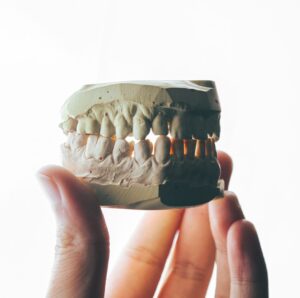 Osteogenesis imperfecta (OI), also known as “brittle bone disease”, is a rare genetic disorder of the skeleton, whose most benign form I corresponds to autosomal dominant mutations in the genes encoding type I collagen (COLA1, COLA2). Several associated skeletal manifestations are often observed but, surprisingly, while dentin defects often reflect genetic bone disorders, about half of OI patients have no obvious oral manifestations. Here, we investigated the collagen, mineral and mechanical properties of dentin from deciduous teeth collected from patients with mild form of OI and displaying no obvious clinical signs of dentinogenesis imperfecta. For the first time, an increase in the hardness of OI dentin associated with an increase in mineral content compared to healthy patients was reported. In addition, OI altered the tissue characteristics of the dentin-enamel junction but the interfacial gradient was preserved. The impact of changes in molecular structure due to mutations in OI was assessed by Raman microspectroscopy. Our results highlighted a change in the hydroxyproline-proline ratio in direct association with collagen mineralization. Our findings suggest that the evaluation of teeth could be an important aid for mild types of OI that are often difficult to diagnose clinically and provide experimental evidence that hydroxyproline content should be considered in future studies on collagen-based biomaterials. Read the whole article here.
Osteogenesis imperfecta (OI), also known as “brittle bone disease”, is a rare genetic disorder of the skeleton, whose most benign form I corresponds to autosomal dominant mutations in the genes encoding type I collagen (COLA1, COLA2). Several associated skeletal manifestations are often observed but, surprisingly, while dentin defects often reflect genetic bone disorders, about half of OI patients have no obvious oral manifestations. Here, we investigated the collagen, mineral and mechanical properties of dentin from deciduous teeth collected from patients with mild form of OI and displaying no obvious clinical signs of dentinogenesis imperfecta. For the first time, an increase in the hardness of OI dentin associated with an increase in mineral content compared to healthy patients was reported. In addition, OI altered the tissue characteristics of the dentin-enamel junction but the interfacial gradient was preserved. The impact of changes in molecular structure due to mutations in OI was assessed by Raman microspectroscopy. Our results highlighted a change in the hydroxyproline-proline ratio in direct association with collagen mineralization. Our findings suggest that the evaluation of teeth could be an important aid for mild types of OI that are often difficult to diagnose clinically and provide experimental evidence that hydroxyproline content should be considered in future studies on collagen-based biomaterials. Read the whole article here.
 Genodermatoses are heritable skin diseases that can cause significant morbidity and mortality. Most of them show characteristic cutaneous findings. Genodermatoses can be associated with extracutaneous system abnormalities. Diagnosing hereditary skin disorders is still a challenging task due to their rarity and diversity, due to diseases evolving over many years, and the initial manifestations not always being diagnostic; therefore, ongoing evaluation and surveillance is often required to make the accurate diagnosis. The algorithm for the diagnosis depends on a combination of thorough clinical and family history clinical examination, laboratory findings, consultation of multiple medical specialists, and molecular analysis. Diagnostic testing targeted at differentiation of similar genodermatoses may be required. Recognition is crucial for the initiation of the treatment for skin manifestations and detection of other extracutaneous abnormalities, including malignancy. Diagnostic accuracy and molecular diagnosis may help in providing a template for ongoing management, testing, and education and prognostication for families of children with genodermatoses. Read the whole article here.
Genodermatoses are heritable skin diseases that can cause significant morbidity and mortality. Most of them show characteristic cutaneous findings. Genodermatoses can be associated with extracutaneous system abnormalities. Diagnosing hereditary skin disorders is still a challenging task due to their rarity and diversity, due to diseases evolving over many years, and the initial manifestations not always being diagnostic; therefore, ongoing evaluation and surveillance is often required to make the accurate diagnosis. The algorithm for the diagnosis depends on a combination of thorough clinical and family history clinical examination, laboratory findings, consultation of multiple medical specialists, and molecular analysis. Diagnostic testing targeted at differentiation of similar genodermatoses may be required. Recognition is crucial for the initiation of the treatment for skin manifestations and detection of other extracutaneous abnormalities, including malignancy. Diagnostic accuracy and molecular diagnosis may help in providing a template for ongoing management, testing, and education and prognostication for families of children with genodermatoses. Read the whole article here.
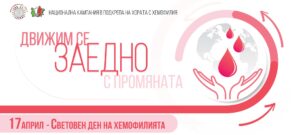 The Bulgarian Hemophilia Association organizes an information campaign on the occasion of the World Hemophilia Day – April 17. The campaign will be held under the title “We are moving together with the change!”, and the association calls on everyone who wish to join the dissemination of information materials that will be published through their communication channels.
The Bulgarian Hemophilia Association organizes an information campaign on the occasion of the World Hemophilia Day – April 17. The campaign will be held under the title “We are moving together with the change!”, and the association calls on everyone who wish to join the dissemination of information materials that will be published through their communication channels.
By bringing together as many people as possible in this year’s hashtag campaign on social media #движимсезаедноспромяната and #световенденахемофилията the association aims first to inform the general public about all the specifics of the disease and the needs of each patient in times of isolation and global pandemic, calling on everyone to be together in this new reality.
More information about the campaign can be found at the following link: https://hemo-bg.org/
8th annual symposium “HEALTH TECHNOLOGY ASSESSMENT – STRATEGIES FOR ACCELERATED ACCESS”, 27 March 2021
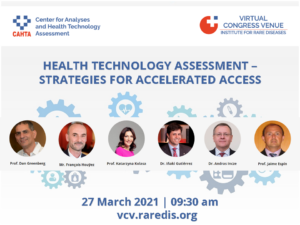 On 27 March 2021 was held the 8th annual symposium “HEALTH TECHNOLOGY ASSESSMENT – STRATEGIES FOR ACCELERATED ACCESS, organized by the Institute for Rare Diseases. For the first year, the event took place online in the digital platform Virtual Congress Venue, thus facilitating interactive discussions between participants from different countries such as the UK, Singapore, Slovakia, Romania, Czech republic, etc. Experts from Israel, Spain, France, Poland, Switzerland and Bulgaria shared their global, country-specific, academic and regulatory experience in international reference pricing, negotiation of discounts and rebates and managed entry agreements. The main topics of the discussions were health technology assessment, sustainable access to innovative therapies within limited budgets, as well as decision-making tools.
On 27 March 2021 was held the 8th annual symposium “HEALTH TECHNOLOGY ASSESSMENT – STRATEGIES FOR ACCELERATED ACCESS, organized by the Institute for Rare Diseases. For the first year, the event took place online in the digital platform Virtual Congress Venue, thus facilitating interactive discussions between participants from different countries such as the UK, Singapore, Slovakia, Romania, Czech republic, etc. Experts from Israel, Spain, France, Poland, Switzerland and Bulgaria shared their global, country-specific, academic and regulatory experience in international reference pricing, negotiation of discounts and rebates and managed entry agreements. The main topics of the discussions were health technology assessment, sustainable access to innovative therapies within limited budgets, as well as decision-making tools.
Information on topics and speakers at: https://vcv.raredis.org/en/event/health-technology-assessment-strategies-for-accelerated-access/
 Vitamin D is a fat-soluble steroid hormone playing a pivotal role in calcium and phosphate homeostasis as well as in bone health. Vitamin D levels are not exclusively dependent on food intake. Indeed, the endogenous production-occurring in the skin and dependent on sun exposure-contributes to the majority amount of vitamin D present in the body. Since vitamin D receptors (VDRs) are ubiquitous and drive the expression of hundreds of genes, the interest in vitamin D has tremendously grown and its role in different diseases has been extensively studied. Several investigations indicated that vitamin D action extends far beyond bone health and calcium metabolism, showing broad effects on a variety of critical illnesses, including cancer, infections, cardiovascular and autoimmune diseases. Epidemiological studies indicated that low circulating vitamin D levels inversely correlate with cutaneous manifestations and bone abnormalities, clinical hallmarks of neurofibromatosis type 1 (NF1). NF1 is an autosomal dominant tumour predisposition syndrome causing significant pain and morbidity, for which limited treatment options are available. In this context, vitamin D or its analogues have been used to treat both skin and bone lesions in NF1 patients, alone or combined with other therapeutic agents. Here we provide an overview of vitamin D, its characteristic nutritional properties relevant for health benefits and its role in NF1 disorder. We focus on preclinical and clinical studies that demonstrated the clinical correlation between vitamin D status and NF1 disease, thus providing important insights into disease pathogenesis and new opportunities for targeted therapy. Read the whole article here.
Vitamin D is a fat-soluble steroid hormone playing a pivotal role in calcium and phosphate homeostasis as well as in bone health. Vitamin D levels are not exclusively dependent on food intake. Indeed, the endogenous production-occurring in the skin and dependent on sun exposure-contributes to the majority amount of vitamin D present in the body. Since vitamin D receptors (VDRs) are ubiquitous and drive the expression of hundreds of genes, the interest in vitamin D has tremendously grown and its role in different diseases has been extensively studied. Several investigations indicated that vitamin D action extends far beyond bone health and calcium metabolism, showing broad effects on a variety of critical illnesses, including cancer, infections, cardiovascular and autoimmune diseases. Epidemiological studies indicated that low circulating vitamin D levels inversely correlate with cutaneous manifestations and bone abnormalities, clinical hallmarks of neurofibromatosis type 1 (NF1). NF1 is an autosomal dominant tumour predisposition syndrome causing significant pain and morbidity, for which limited treatment options are available. In this context, vitamin D or its analogues have been used to treat both skin and bone lesions in NF1 patients, alone or combined with other therapeutic agents. Here we provide an overview of vitamin D, its characteristic nutritional properties relevant for health benefits and its role in NF1 disorder. We focus on preclinical and clinical studies that demonstrated the clinical correlation between vitamin D status and NF1 disease, thus providing important insights into disease pathogenesis and new opportunities for targeted therapy. Read the whole article here.
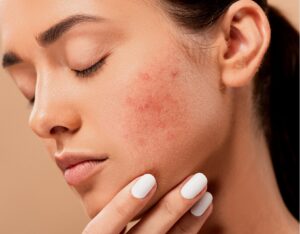 Mastocytosis is a rare disease characterised by expansion and collection of clonal mast cells in various organs including the skin, bone marrow, spleen, lymph nodes and gastrointestinal tract. The prevalence of mastocytosis has been estimated to be one in 10 000, while the estimated incidence is one per 100 000 people per year. Cutaneous mastocytosis is classified into (i) maculopapular cutaneous mastocytosis, also known as urticaria pigmentosa; (ii) diffuse cutaneous mastocytosis; and (iii) mastocytoma of the skin. In adults, cutaneous lesions are usually associated with indolent systemic mastocytosis and have a chronic evolution. Paediatric patients, on the contrary, have often cutaneous manifestations without systemic involvement and usually experience a spontaneous regression. Diagnosis of cutaneous mastocytosis may be challenging due to the rarity of the disease and the overlap of cutaneous manifestations. This short review describes pathogenesis and clinical aspects of cutaneous mastocytosis with a focus on diagnosis and currently available therapies. Read the whole article here.
Mastocytosis is a rare disease characterised by expansion and collection of clonal mast cells in various organs including the skin, bone marrow, spleen, lymph nodes and gastrointestinal tract. The prevalence of mastocytosis has been estimated to be one in 10 000, while the estimated incidence is one per 100 000 people per year. Cutaneous mastocytosis is classified into (i) maculopapular cutaneous mastocytosis, also known as urticaria pigmentosa; (ii) diffuse cutaneous mastocytosis; and (iii) mastocytoma of the skin. In adults, cutaneous lesions are usually associated with indolent systemic mastocytosis and have a chronic evolution. Paediatric patients, on the contrary, have often cutaneous manifestations without systemic involvement and usually experience a spontaneous regression. Diagnosis of cutaneous mastocytosis may be challenging due to the rarity of the disease and the overlap of cutaneous manifestations. This short review describes pathogenesis and clinical aspects of cutaneous mastocytosis with a focus on diagnosis and currently available therapies. Read the whole article here.
 The 11th National Conference for Rare Diseases and Orphan Drugs, organized by the Institute for Rare Diseases, was held on 11-12 September, 2020. The event was held online for the first year, in a specially developed digital platform – Virtual Congress Venue. The conference presented the new and current trends in the diagnosis, treatment and monitoring of rare diseases, the development of European reference networks and access to innovative technologies. A proceedings book with all presentations and materials presented at the conference are published as a supplement to the scientific journal “Rare Diseases and Orphan Drugs” and can be viewed at the following link.
The 11th National Conference for Rare Diseases and Orphan Drugs, organized by the Institute for Rare Diseases, was held on 11-12 September, 2020. The event was held online for the first year, in a specially developed digital platform – Virtual Congress Venue. The conference presented the new and current trends in the diagnosis, treatment and monitoring of rare diseases, the development of European reference networks and access to innovative technologies. A proceedings book with all presentations and materials presented at the conference are published as a supplement to the scientific journal “Rare Diseases and Orphan Drugs” and can be viewed at the following link.
 This year in Plovdiv Rare Disease Day will be celebrated on 28 February, 2021. The initiative will be held under the motto “We are many, we are strong, we are united”. The main focus of the event is pictures with colorful messages, and the different colors are symbol of the thousands types of rare diagnoses in the world. The initiative is organized jointly with the National Alliance of People with Rare Diseases and the HAE Association (hereditary angioedema). Students from the Professional School of Food Technology – Plovdiv, will also take part in the celebration of this important event.
This year in Plovdiv Rare Disease Day will be celebrated on 28 February, 2021. The initiative will be held under the motto “We are many, we are strong, we are united”. The main focus of the event is pictures with colorful messages, and the different colors are symbol of the thousands types of rare diagnoses in the world. The initiative is organized jointly with the National Alliance of People with Rare Diseases and the HAE Association (hereditary angioedema). Students from the Professional School of Food Technology – Plovdiv, will also take part in the celebration of this important event.
Every year the Rare Disease Day is on the last day of February. The main goal of the campaign is to raise public awareness and the opportunity for timely diagnosis and treatment of those who are affected. The initiative is set up by EURORDIS and the Council of National Alliances for Rare Diseases in 2008 and gradually becoming a global phenomenon. Hundreds of cities take part in this large-scale campaign every year. Due to the pandemic situation, all events will be organized according to the imposed measures.
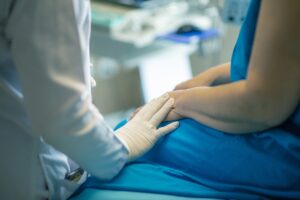
Acromegaly is a rare disease with a peak of incidence in early adulthood. However, enhanced awareness of this disease, combined with wide availability of magnetic resonance imaging (MRI), has increased the diagnosis of forms with mild presentation, especially in elderly patients. Moreover, due to increased life expectancy and proactive individualized treatment, patients with early-onset acromegaly are today aging. The aim of our study was to describe our cohort of elderly patients with acromegaly.
This is a cross-sectional retrospective study of 96 outpatients. Clinical, endocrine, treatment, and follow-up data were collected using the electronic database of the University Hospital of Padova, Italy.
We diagnosed acromegaly in 13 patients, aged ≥65 years, presenting with relatively small adenomas and low IGF-1 secretion. Among them, 11 patients were initially treated with medical therapy and half normalized hormonal levels after 6 months without undergoing neurosurgery (TNS). Remission was achieved after TNS in three out of four patients (primary TNS in two); ten patients presented controlled acromegaly at the last visit. Acromegaly-related comorbidities (colon polyps, thyroid cancer, adrenal incidentaloma, hypertension, and bone disease) were more prevalent in patients who had an early diagnosis (31 patients, characterized by a longer follow-up of 24 years) than in those diagnosed aged ≥65 years (5 years of follow-up).
Elderly acromegalic patients are not uncommon. Primary medical therapy is a reasonable option and is effectively used, suggesting cost-benefit balance. Disease-specific comorbidities are more prevalent in acromegalic patients with a longer follow-up rather than in those diagnosed aged ≥65 years. Read the whole article here.
